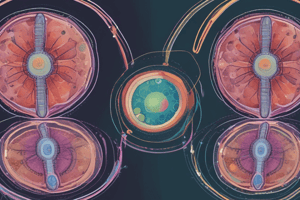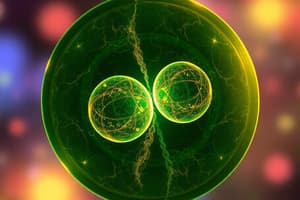Podcast
Questions and Answers
What occurs during anaphase in relation to sister chromatids?
What occurs during anaphase in relation to sister chromatids?
- Sister chromatids separate and move towards opposite poles. (correct)
- Sister chromatids undergo mutation during separation.
- Sister chromatids align at the equatorial plate.
- Sister chromatids replicate to form double the amount.
Which process describes the arrangement and separation of homologous pairs prior to receiving maternal or paternal DNA?
Which process describes the arrangement and separation of homologous pairs prior to receiving maternal or paternal DNA?
- Anaphase I (correct)
- Telophase II
- Metaphase II
- Cytokinesis
What is the role of mitotic spindle fibers during telophase II?
What is the role of mitotic spindle fibers during telophase II?
- They facilitate the disintegration of sister chromatids.
- They disintegrate before cytokinesis is completed. (correct)
- They help in the replication of DNA.
- They align the chromosomes at the spindle equator.
What defines a chromosome in genetic terms?
What defines a chromosome in genetic terms?
Which of the following statements about sister chromatids is incorrect?
Which of the following statements about sister chromatids is incorrect?
What is the purpose of genetic engineering in organisms?
What is the purpose of genetic engineering in organisms?
How does meiosis contribute to genetic diversity?
How does meiosis contribute to genetic diversity?
What is indicated by the term adaptation in biology?
What is indicated by the term adaptation in biology?
Which statement accurately portrays GMOs?
Which statement accurately portrays GMOs?
What happens when a cell error occurs in the body?
What happens when a cell error occurs in the body?
What occurs when an animal cell is placed in a hypotonic solution?
What occurs when an animal cell is placed in a hypotonic solution?
What is the role of the large central vacuole in plant cells?
What is the role of the large central vacuole in plant cells?
What happens during plasmolysis in plant cells?
What happens during plasmolysis in plant cells?
What defines an isotonic solution?
What defines an isotonic solution?
What is the primary cause of turgor pressure in plant cells?
What is the primary cause of turgor pressure in plant cells?
What happens to a cell if it is not repairable?
What happens to a cell if it is not repairable?
What is a common consequence of mitotic errors?
What is a common consequence of mitotic errors?
What type of chromosomal abnormality occurs during nondisjunction?
What type of chromosomal abnormality occurs during nondisjunction?
Which of the following is associated with an increased risk of cancer?
Which of the following is associated with an increased risk of cancer?
What is the result of aneuploidy?
What is the result of aneuploidy?
Which of the following cancers is commonly recognized by WHO?
Which of the following cancers is commonly recognized by WHO?
Which factor is NOT associated with increased cellular mutations?
Which factor is NOT associated with increased cellular mutations?
What is polyploidy characterized by?
What is polyploidy characterized by?
What happens to the lipid tails in the plasma membrane when they become straight?
What happens to the lipid tails in the plasma membrane when they become straight?
How does the fluid mosaic model describe the nature of the plasma membrane?
How does the fluid mosaic model describe the nature of the plasma membrane?
Which type of diabetes results from the body not producing insulin?
Which type of diabetes results from the body not producing insulin?
Which statement accurately describes Type II Diabetes Insipidus?
Which statement accurately describes Type II Diabetes Insipidus?
What is one symptom common in both Type I and Type II Diabetes?
What is one symptom common in both Type I and Type II Diabetes?
What role does flexibility in the plasma membrane play for cells?
What role does flexibility in the plasma membrane play for cells?
How does the presence of unsaturated fats affect the fluidity of the plasma membrane?
How does the presence of unsaturated fats affect the fluidity of the plasma membrane?
What is a consequence of a rigid plasma membrane in a cell?
What is a consequence of a rigid plasma membrane in a cell?
What is the primary function of mitosis?
What is the primary function of mitosis?
During which phase of mitosis do microtubules attach to the chromosomes?
During which phase of mitosis do microtubules attach to the chromosomes?
Which phase of the cell cycle includes checkpoints to monitor cell health before mitosis?
Which phase of the cell cycle includes checkpoints to monitor cell health before mitosis?
What happens to the chromatin during prophase?
What happens to the chromatin during prophase?
Which statement regarding cytokinesis is true?
Which statement regarding cytokinesis is true?
In which phase do the centrosomes migrate to opposite poles?
In which phase do the centrosomes migrate to opposite poles?
How does the chromosome number change during meiosis compared to mitosis?
How does the chromosome number change during meiosis compared to mitosis?
What is one of the key differences between mitosis and meiosis?
What is one of the key differences between mitosis and meiosis?
Flashcards
Homologous Pairs
Homologous Pairs
Chromosomes that are paired up during meiosis and are composed of two identical sister chromatids. One sister chromatid is a copy of the other (the maternal or paternal chromosome).
Anaphase I
Anaphase I
A stage in meiosis where the homologous chromosomes separate and move to opposite poles of the cell. This is where the original chromosome from the mother and father are separated.
Meiosis
Meiosis
The process of cell division that includes two rounds of division. It starts off with a diploid cell and ends with four haploid daughter cells.
Chromosome
Chromosome
Signup and view all the flashcards
Sister Chromatids
Sister Chromatids
Signup and view all the flashcards
Genetic Engineering
Genetic Engineering
Signup and view all the flashcards
GMO (Genetically Modified Organism)
GMO (Genetically Modified Organism)
Signup and view all the flashcards
Adaptation
Adaptation
Signup and view all the flashcards
Genetic Diversity
Genetic Diversity
Signup and view all the flashcards
Interphase
Interphase
Signup and view all the flashcards
Prophase
Prophase
Signup and view all the flashcards
Metaphase
Metaphase
Signup and view all the flashcards
Telophase
Telophase
Signup and view all the flashcards
Cytokinesis
Cytokinesis
Signup and view all the flashcards
Apoptosis (Programmed Cell Death)
Apoptosis (Programmed Cell Death)
Signup and view all the flashcards
Mitotic Errors
Mitotic Errors
Signup and view all the flashcards
Nondisjunction
Nondisjunction
Signup and view all the flashcards
Aneuploidy
Aneuploidy
Signup and view all the flashcards
Polyploidy
Polyploidy
Signup and view all the flashcards
Cancer
Cancer
Signup and view all the flashcards
Tonicity
Tonicity
Signup and view all the flashcards
Isotonic Solution
Isotonic Solution
Signup and view all the flashcards
Hypotonic Solution
Hypotonic Solution
Signup and view all the flashcards
Hypertonic Solution
Hypertonic Solution
Signup and view all the flashcards
Plasma Membrane: Function
Plasma Membrane: Function
Signup and view all the flashcards
Plasma Membrane: Fluidity
Plasma Membrane: Fluidity
Signup and view all the flashcards
Fluid Mosaic Model
Fluid Mosaic Model
Signup and view all the flashcards
Type I Diabetes
Type I Diabetes
Signup and view all the flashcards
Type II Diabetes
Type II Diabetes
Signup and view all the flashcards
Insulin
Insulin
Signup and view all the flashcards
Diabetes Symptoms
Diabetes Symptoms
Signup and view all the flashcards
Diabetic Ketoacidosis
Diabetic Ketoacidosis
Signup and view all the flashcards
Study Notes
Mitosis
- Mitosis is a process where a cell divides to produce two identical daughter cells.
- It only occurs in somatic (body) cells, and takes up about 10% of the cell cycle.
- The other 90% is interphase, which is the preparation phase for mitosis, where the chromosome is in the form of chromatin.
- Interphase consists of Gap 0, Gap 1, S phase, and Gap 2.
Mitosis Phases
- Prophase: Chromatin condenses, nucleus disintegrates and spindle fibers form.
- Prometaphase: Nuclear envelope dissolves, centrosomes move to opposite poles, and spindle fibers finish forming.
- Metaphase: Microtubules attach to chromosomes in the middle of the cell.
- Anaphase: Mitotic spindle fibers separate sister chromatids and move them to opposite poles.
- Telophase: The now daughter chromosomes decondense.
- Cytokinesis: The cell divides into two daughter cells.
Meiosis
- Meiosis is a process that undergoes PMAT and cytokinesis twice to produce sex cells (gametes).
- The number of chromosomes decreases to half during meiosis.
- Meiosis 1 is a reduction division, reducing the number of chromosomes.
- Meiosis 2 is an equational division, restorering the chromosome number during fertilization.
Significance of Mitosis and Meiosis
- Mitosis maintains genetic material (genome).
- Mitosis ensures proper cell function and maintains the same number of chromosomes by duplicating and dividing chromosomes.
- Meiosis reduces chromosome number by half producing gametes for sexual reproduction.
- Meiosis also introduces genetic variation through crossing over.
Significance of Meiosis
- Reduction of genetic material and sexual reproduction.
- Genetic diversity.
- Survival.
Biological Significance of Crossing Over
- Crossing over is an exchange of genetic material/segments which helps to increase genetic diversity and enhances genetic variation.
Cancer
- Cancer is an error in cell checkpoints that stops apoptosis which causes abnormal growth.
- Neoplasm forms when defective cells grow into tumors.
- Early detection is the most effective way to treat cancer.
Nondisjunction Disorders
- Polyploidy: Abnormal number of sets of chromosomes.
- Aneuploidy: Abnormal number of chromosomes.
- Down syndrome: An example of an aneuploidy disorder where there is an extra chromosome 21 (Trisomy 21).
Other Genetic Disorders
- Patau Syndrome (Trisomy 13): Characterized by cleft lip, cleft palate, cerebral defects, and holoprosencephaly.
- Edward Syndrome (Trisomy 18): Characterized by heart complications.
- Turner Syndrome (Monosomy X): A chromosomal disorder affecting females, causing characteristic features, short stature, broad shoulders, and developmental delays.
- Warkany Syndrome (Chromosome 8): Characterized by stiff joints, congenital abnormalities, and delayed development.
Stem Cells
- Undifferentiated cells that can become specialized cells.
- Stem cell technology is used in replacing old and damaged cells.
- Stem cells derive from embryonic stem cells or adult stem cells.
Genetic Engineering
- Genetic engineering is a process to directly modify the DNA of an organism to produce new traits.
- All genetically engineered organisms are GMOs, but not all GMOs are genetically engineered.
Cellular Transport
- Diffusion: Movement of molecules from a higher concentration to a lower concentration until equilibrium is reached.
- Osmosis: Movement of water across a semi-permeable membrane from a lower solute concentration to a higher solute concentration.
Passive Transport
- Simple Diffusion: Movement of small, nonpolar molecules across a membrane without the aid of transport proteins.
- Facilitated Diffusion: Movement of molecules across a membrane with the help of transport proteins.
Active Transport
- Active Transport: Movement of molecules against their concentration gradient, requiring energy.
- Sodium-Potassium Pump: An example of an active transport mechanism that moves sodium ions out of a cell and potassium ions into a cell.
Bulk Transport
- Vesicles: Small sacs that transport materials within and between cells.
- Exocytosis: Vesicles fusing with the plasma membrane to release their contents outside the cell.
- Endocytosis: The process of taking substances into the cells by enveloping them in a vesicle.
- Phagocytosis: Cell eating, engulfing particles (bacteria).
- Pinocytosis: Cell drinking, engulfing fluids.
- Receptor-mediated Endocytosis: Specialized endocytosis usingreceptor proteins to capture specific molecules.
Factors Affecting Cell Transport
- Concentration Gradient: Difference in concentration between two areas.
- Size of molecules: Smaller molecules diffuse faster than larger ones.
- Membrane permeability: How easily substances can pass through a membrane.
Studying That Suits You
Use AI to generate personalized quizzes and flashcards to suit your learning preferences.




